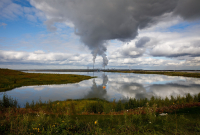Support strong Canadian climate journalism for 2025
The Oil Sands Pathways to Net Zero Initiative, announced June 9, may well lower greenhouse gas emissions from bitumen extraction and help Canada meet its own net-zero-by-2050 goal. Unfortunately, that is not enough. Climate change is only one of three significant risks facing the industry. The others are peak oil demand and at least $31 billion of environmental liabilities for 37 toxic northern Alberta tailings ponds. CEOs coming to Ottawa cap in hand for $50 billion of subsidies may be Canada's last chance to address all three issues and put the oilsands on a path to long-term environmental and financial sustainability. The opportunity must not be missed.
My 2019 book, The New Alberta Advantage: Technology, policy and the future of the oil sands, also focused on emissions' reduction. The energy transition was in a lower gear then, and transformative change seemed another decade or two away. Lowering emissions in anticipation of global carbon pricing policies seemed smart: address climate change and gain a competitive advantage over high-carbon heavy crudes from competitors like Venezuela and Mexico. Arguing that "when the energy transition is complete and the last drop of heavy crude oil is refined or processed sometime this century, it will be an Alberta drop" seemed reasonable.
But just as the book was hitting the presses, the energy transition grabbed a higher gear and accelerated. Even experts who lived and breathed the transition were caught off-guard as technology milestones expected in 2030 arrived a decade early.
Electric transportation in particular — cars and trucks, buses, delivery vans, commercial vehicles, bicycles, robo-taxis, automated shuttles and much more — has experienced dramatic advances. The signs are all around us. Automakers are all in on electric. Transit authorities are ditching diesel buses. Battery costs are plummeting while new technologies like solid-state (uses a solid electrolyte instead of liquid, which enables longer range and greater safety) promise a major improvement only a few years from now. And every new EV sales forecast from BloombergNEF features a steeper curve than the last one.
Since ground transportation consumes just under half of global oil supply, the electrification of transportation is the biggest determinant of peak oil demand. The International Energy Agency (IEA) thinks peak oil will arrive in the late 2020s or early 2030s, while other forecasters think it will happen earlier. The next question is the shape of the decline curve: Will it be steep or shallow? Speedier electrification suggests peak oil demand will arrive sooner than the IEA predicts and the decline will be more rapid.
But we don’t really know. The 2020s are shaping up to be the disruptive decade of this energy transition. A good bet is that when 2030 arrives, most of our current assumptions about the future of oil will prove to be quite conservative.
Yet, the companies of the Oil Sands Pathways to Net Zero initiative assure us that "all internationally recognized forecasts indicate fossil fuels will continue to be an essential requirement through 2050 and beyond as part of a diversified energy mix." They are misleading Canadians. For example, consider the IEA, often cited by industry supporters.
"The IEA doesn’t have a long-term forecast," economist Tim Gould, who supervises the agency's modelling analysis, told Energi Media. "We differentiate between the near-term horizon, those stretch out typically for five years, but once you start looking beyond that, you move into scenario territory."
In May, the agency added a much-discussed net-zero-by-2050 scenario in which oil consumption falls from 100 million to 30 million barrels per day by mid-century. Global governments ratcheting up climate policy, a feature of the past two years, combined with intense technology disruption suggests the net-zero-by-2050 outcome is not far-fetched.
Therefore, it is fair to argue the risk posed to the oilsands by the electrification of transportation is substantial. But electric transportation isn't the only risk in play.
What if the net-zero pathways initiative fails?
Oilsands companies are asking the Alberta and Canadian governments for tens of billions because they need to "de-risk" the early stage technologies they hope to deploy — scaling up carbon capture and storage, hydrogen and small modular reactors, to name the big ones. Economist Jason Dion calls these technologies "wild cards." They show promise and their development should receive public support, but most won't be commercial until after 2030, if they ever are.
And the sector's historical record isn't encouraging.
While the industry boasts about a 20 per cent reduction in emissions per barrel from 2009 to 2019 — from 87 to 70 kilograms of CO2 equivalent (CO2e) per barrel — that still leaves diluted bitumen among the most carbon-intense crude oils in the world. And buried in the IHS MarkIt data is a concerning trend for in-situ production, with 2018 in-situ production intensity rising by one per cent and cyclic steam stimulation by nine per cent.
Source: IHS MarkIt
While the companies of the pathways initiative try to focus public attention on falling emissions intensity, the real story is the rise of absolute oilsands emissions over less than a decade, from 69 to 80 megatonnes of CO2e annually, according to the 2020 IHS MarkIt study “The GHG intensity of Canadian oil sands production: A new analysis.” The culprit here is the doubling of heavy crude production from 1.5 million to three million barrels per day. When emissions drop by 20 per cent, but supply grows by 100 per cent, the math doesn’t work in the oil companies’ favour.
With production set to grow another 650,000 barrels per day by 2030, the record suggests total emissions will rise again.
Keep in mind that this analysis is based upon the authoritative work of IHS MarkIt economist Kevin Birn. Other researchers, such as the Pembina Institute, estimate emissions intensity and absolute emissions to be higher.
There is a third significant risk to be considered: the oilsands' enormous environmental liabilities. Despite considerable investment over the years, there is still no credible technology to reclaim the 1.3 trillion litres of toxic waste in northern Alberta's 37 tailings ponds. Oilsands liabilities are conservatively estimated at $31 billion, but only $900 million has been deposited with the provincial government to pay for clean up. And the current Alberta government is actually relaxing already lax regulations that look great on paper but have yet to yield tangible results.
Despite three significant risks — imminent market destruction, climate and emissions, and environmental liabilities — there are two reasons why the oilsands could still have a sustainable long-term future.
One, bitumen is now a competitive barrel because production costs have plummeted. Most break-evens are below $40 per barrel of West Texas Intermediate. Suncor, for example, claimed in its 2021 investor presentation that its break-even averaged $35, forecast to be $28 by 2025. The oilsands are now viable during periods of low prices or market volatility.
And when prices are high, as they are now at over $70, the industry is a free cashflow machine. Suncor, CNRL, Cenovus and Imperial Oil expect to return tens of billions to shareholders over the next four years via dividends and share buybacks.
Two, and perhaps most importantly, Alberta Innovates thinks that in five to seven years, bitumen will be used to manufacture cheap and plentiful carbon fibre. The value of a barrel of bitumen will double or triple, according to the provincial agency’s estimates. The Bitumen Beyond Combustion program has also identified other higher-value uses for bitumen, including activated carbon and asphalt for road building.
Consequently, the oilsands stand at a crossroads.
The industry can implement its net-zero by 2050 plan to mitigate climate risk, embark on an energy transition strategy that sees it pivot to non-combustion applications for bitumen and finally begin to properly reclaim the tailings ponds. This would set up a post-combustion future that could be long (perhaps past 2100), environmentally sustainable and prosperous for the companies, workers and taxpayers.
Or the CEOs can do the minimum — decarbonization — and roll the dice.
The Canadian government will determine the path taken by the oilsands. Premier Jason Kenney and his United Conservative Party government, continuing their uncritical and unwavering support for the hydrocarbon industry, signed on early to the pathways initiative. Prime Minister Justin Trudeau and his Liberal government did not. Ottawa was noticeably absent from the announcement.
Yet, the oil companies involved in the pathways initiative said in their press release that federal financial support is critical to the initiative’s success: “We look forward to continued collaboration with both the federal and Alberta governments to create the regulatory and policy certainty and fiscal framework needed to ensure the economic viability of this initiative.”
The price Trudeau should insist upon for federal participation is that the pathways initiative address all three risks: climate, peak oil and environmental liabilities. His message should be that it’s all or nothing. The Oil Sands Pathways to Net Zero Initiative is a rare opportunity for the Canadian government to influence positive structural change in the oil and gas industry in a way that revives investment, creates jobs, increases tax revenue and helps Canada meet its climate targets.
That opportunity to reshape the Alberta Advantage must not be missed.
Markham Hislop is a Canadian energy and climate journalist and host of the Energi Talks podcast.







Comments
Hislop: "The Oil Sands Pathways to Net Zero Initiative may well lower greenhouse gas emissions from bitumen extraction and help Canada meet its own net-zero-by-2050 goal."
Oil companies' net-zero upstream emissions targets amount to greenwashing. Even if upstream emissions (from extraction activities) are reduced to zero, this does nothing to offset or reduce downstream (tailpipe) emissions at the consumer end. The oil industry has no way to decarbonize the downstream combustion of fossil fuels, where 80% of the emissions from a barrel of oil occur.
Carbon capture is corporate greenwashing to perpetuate fossil fuels. The industry's plan is to "green" fossil fuels, not get off them.
A climate plan doomed to fail.
Contrast the IEA's recent report: "Net Zero by 2050"
"Net Zero by 2050: A Roadmap for the Global Energy Sector" (IEA, May 2021)
"The IEA concluded that the Paris Agreement goal to limit global warming to 1.5 C demands a 75% reduction in oil consumption by 2050, with no investments in new fossil fuel supply starting today."
IEA World Energy Outlook special report: "The Oil and Gas Industry in Energy Transitions" (January 2020)
"Regardless of which pathway the world follows, climate impacts will become more visible and severe over the coming years, increasing the pressure on all elements of society to find solutions. THESE SOLUTIONS CANNOT BE FOUND WITHIN TODAY'S OIL AND GAS PARADIGM."
Required reading:
"Why you should take oilsands giants' net-zero pledge with a barrel of skepticism" (National Observer, June 10th 2021)
https://www.nationalobserver.com/2021/06/10/opinion/why-oilsands-giants…
Subsidies to reduce oil industry emissions violate the polluter-pay principle. Huge opportunity costs.
"What's the cost of cutting oilsands' carbon emissions? A cool $75 billion" (Bloomberg News, Jul 08, 2021)
"It will cost about $75 billion to zero out GHGs from oilsands operations by 2050, with a good deal of the costs borne by taxpayers and many loose ends yet to be tied up, according to two of the industry’s top CEOs.
https://financialpost.com/commodities/energy/oil-gas/oil-sands-carbon-c…
"The [oilsands] companies say the [Pathways to Net Zero] project will need significant investments and was made possible because of support programs from the federal and Alberta governments."
https://globalnews.ca/news/7934309/canadian-oilsands-net-zero-emitters/
Oil companies are happy to reduce their grossly under-reported upstream emissions as long as taxpayers foot the bill. Taxpayers will be on the hook for carbon capture and SMRs, as well as cleanup and reclamation afterwards.
In March 2021, Premier Kenney asked Ottawa for $30 billion in funding for carbon capture.
If carbon capture (CCS) is viable, let industry pay for it. No reason taxpayers should foot the bill to curb industry's pollution, including carbon emissions.
Privatize the profits, socialize the costs. The fossil fuel industry's business model.
We need to invest in real solutions, like renewable energy, public transit, etc.
AB's oil & gas industry has barely started to fund its clean-up liabilities: north of $260 billion. The industry is turning to taxpayers for bailouts while milking govts for subsidies.
The oil & gas industry has been digging into taxpayers' pockets for reclamation and cleanup costs for over a decade. Now it wants our tax dollars to cut emissions.
The oil & gas industry can easily afford to clean up after itself and invest in emissions-reduction technology. Taxpayer help not required.
"Canadian Natural expects to generate between $2 billion and $2.5 billion of profit in 2021, based on benchmark oil prices of $45 US per barrel. This week, prices are around $60 US."
https://www.cbc.ca/news/business/bakx-oilsands-renewables-enbridge-1.59…
"$100 million in federal funding for cleanup of Alberta oil and gas wells went to sites licensed to CNRL" (The Narwhal, May 7, 2021)
"Canadian Natural Resources Limited — which has reported an average annual profit of $1.9 billion over the last decade — benefited most from taxpayer-funded cleanup of derelict wells"
"Canadian Natural expects to generate up to C$5.4 billion in free cash flow in 2021, from C$692 million last year. Suncor projects additional cash flow of C$400 million this year and C$1 billion by 2023. Cenovus could generate C$3.5 billion this year, analysts at investment bank Morgan Stanley estimate, from a loss last year."
"Canada's cash-rich oil sands firms face pressure to spend on transition" (Reuters, Apr 01, 2021)
Hislop: "bitumen is now a competitive barrel because production costs have plummeted"
Bitumen is competitive only because the industry externalizes health, environmental, and climate costs. Milking govts for endless subsidies for cleanup and reclamation. Corporate welfare. Sticking taxpayers, future generations, and other species with the bill.
Voodoo economics.
Non-combustion uses for oil — carbon fibre, activated carbon, and asphalt — are hardly enough to sustain current global production of 100 millions barrels per day.
If the world burns less heavy oil from Canada, that's a global benefit. If the world takes real action on climate, AB's heavy sour barrels — low quality, costly to extract, more expensive to refine, and remote from distant markets — will be among the first to be stranded.
The last barrel of oil will come from the cheapest, least carbon-intensive production. Not Alberta.
If Ottawa has billions of (our) dollars to bail out the oil industry, it has billions of dollars to invest in our sustainable, renewable future.
You can’t build an energy future by bailing out the past.
Lot of very clever stuff in this article, but almost all of it came down to looking for excuses to keep having Alberta make oil to burn.
There was ONE brief point that could potentially be promising: Using bitumen to make carbon fibre. If you're spinning the gunk into a lightweight structural material, you're not burning it. The extraction process is still dirty as all get out, but at least it's not creating a product designed to emit CO2 when used. Or be transported through leaky pipelines to goop everyone up.
But that sounds like it's still in the lab. Lots of nice ideas never make it out of the lab, so we'll see.
If costs are about $30 per barrel and the selling price is $70 per barrel then the oil companies are making enormous profits. There is absolutely no reason for any government subsidies, and they should be cleaning up the messes they have made before feeding $ to shareholders.